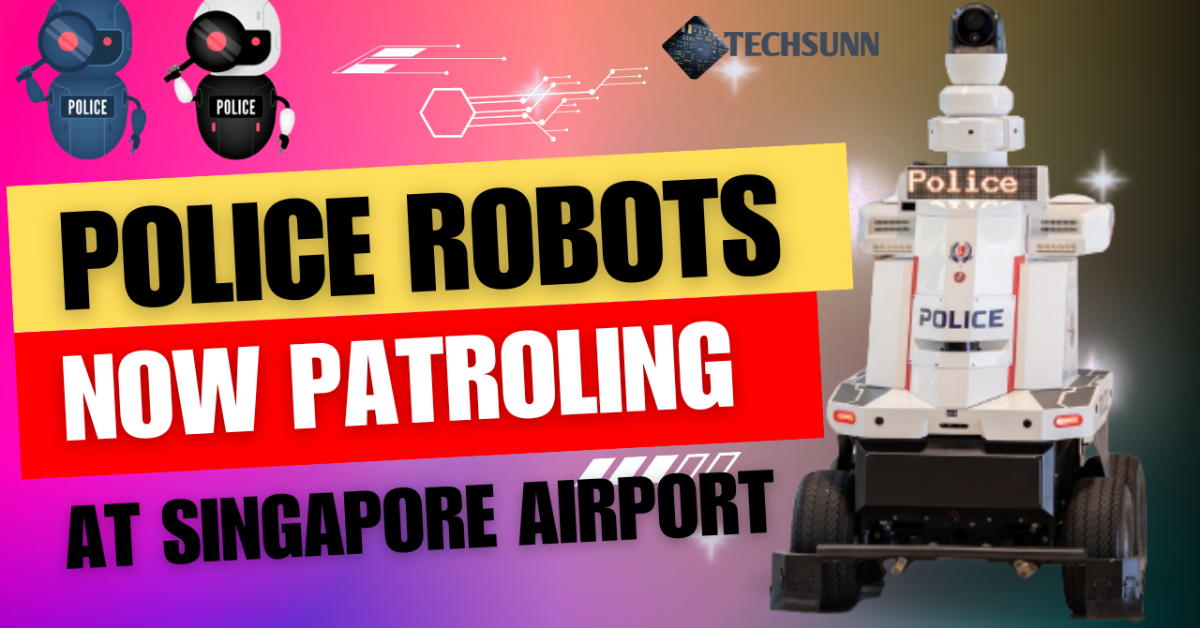Police Robots At Singapore Airport: Advancing Security With Technology

As of late, headways in innovation have upset different ventures, and policing no exemption. One of the amazing advancements in the field of policing is the sending of police robots. These mechanical partners are presently making their attendance felt at Singapore Air terminal, assuming an essential part in keeping up with security and guaranteeing the wellbeing of explorers. In this article, we will investigate the development of police robots, their functionalities, and the effect they have on air terminal security.
1-The Rise of Police Robots
1.1 Introduction to Police Robots
Police robots are sophisticated machines equipped with advanced technology to perform various law enforcement tasks. They are designed to assist human officers in maintaining security, handling emergencies, and combating criminal activities. These robots are becoming increasingly prevalent in different sectors, including airports, where their presence has proven to be a valuable asset in ensuring public safety.
1.2 Adoption of Police Robots in Airports
Airports are bustling hubs with millions of passengers traveling every day. With the constant need for vigilant security measures, airports are turning to innovative solutions like police robots to enhance their security systems. Singapore Airport, known for its technological advancements, has implemented the use of these robots to reinforce security protocols and improve overall efficiency.
2-Functions and Capabilities of Police Robots

2.1 Surveillance and Monitoring
One of the primary functions of police robots is surveillance and monitoring. Equipped with high-definition cameras and sensors, these robots can scan the airport premises, identify suspicious activities, and capture real-time footage. By patrolling designated areas, they provide an additional layer of security, complementing the efforts of human officers.
2.2 Threat Detection and Prevention
Police robots utilize cutting-edge technology to detect potential threats, such as unattended bags or unauthorized access to restricted areas. With their advanced sensors, they can identify suspicious objects and notify human officers for further investigation. This proactive approach helps prevent security breaches and ensures a swift response to any potential dangers.
Custom Helmets that Resemble Your Actual Face
2.3 Assistance to Human Officers
In addition to surveillance and threat detection, police robots offer valuable assistance to human officers. They can be programmed to perform routine tasks like information dissemination, guiding passengers, or providing language translations. This frees up human officers’ time, allowing them to focus on more critical law enforcement duties while ensuring a seamless airport experience for travelers.
Read Also Technology’s Effect on Society: Pros & Cons
3-Benefits of Police Robots at Singapore Airport
3.1 Enhanced Security Measures
The presence of police robots at Singapore Airport strengthens security measures, providing an added sense of safety for passengers and staff. Their constant vigilance, coupled with the ability to cover large areas efficiently, minimizes the risk of security breaches and potential threats. This contributes to an overall safer environment within the airport premises.
3.2 Efficiency and Cost-Effectiveness
Deploying police robots in airports improves operational efficiency and cost-effectiveness. These robots can work tirelessly without fatigue, reducing the need for additional human personnel. With their ability to cover vast distances and perform multiple tasks simultaneously, they optimize resource allocation and streamline security protocols, resulting in cost savings for airport authorities.
3.3 Improved Passenger Experience
By ensuring robust security measures, police robots contribute to an improved passenger experience. Travelers feel reassured knowing that advanced technology is actively monitoring the airport premises. Additionally, the assistance provided by these robots, such as guiding passengers to their respective gates or providing information about flights, enhances overall customer service and satisfaction.
Microsoft to Coordinate GPT-4 in Office Programming
4-Challenges and Limitations of Police Robots
4.1 Ethical Considerations
The implementation of police robots raises ethical considerations regarding privacy and human rights. Finding some kind of harmony among security and individual protection is critical. There ought to be clear rules set up to guarantee that information gathered by these robots is utilized capably and doesn’t encroach upon individual freedoms.
4.2 Human-Machine Collaboration
While police robots offer significant benefits, effective collaboration between humans and machines is vital. Human officers should receive proper training to understand and maximize the potential of these robotic assistants. Maintaining a harmonious relationship between humans and robots ensures optimal performance and utilization of resources.
Top 15 WordPress Hosting Providers for 2023
5.Future Prospects and Innovations in Police Robotics
5.1 Integration of Artificial Intelligence
The future of police robotics lies in the integration of artificial intelligence (AI). By incorporating AI algorithms, robots can learn and adapt to changing security scenarios, improving their ability to detect and respond to potential threats. Machine learning capabilities will enable these robots to become more efficient and make autonomous decisions, further enhancing security measures.
5.2 Autonomous Patrolling and Response
Continued advancements in robotics technology aim to enable police robots to operate autonomously, patrolling airport premises and responding to security incidents without human intervention. With increased autonomy, these robots can offer real-time monitoring, immediate threat assessment, and faster response times, bolstering overall security effectiveness.
6.Conclusion
The introduction of police robots at Singapore Airport signifies a significant step forward in leveraging technology for enhanced security. These robots, with their surveillance capabilities, threat detection systems, and assistance functionalities, contribute to creating a safer environment for passengers and staff alike. While ethical considerations and human-machine collaboration remain important aspects, the future prospects of police robotics, including the integration of AI and autonomous patrolling, promise even greater advancements in airport security.
FAQs (Frequently Asked Questions) About Police Robots
Q: Are police robots replacing human officers at Singapore Airport?
A: No, police robots are deployed as complementary assets to human officers, augmenting their capabilities and improving overall security
Q: Can police robots detain individuals or make arrests?
A: No, police robots are not designed to perform physical apprehensions. They primarily serve as surveillance tools and provide support to human officers.
Q: How do police robots detect potential threats?
A: Police robots employ advanced sensors and algorithms to identify suspicious activities, unattended bags, or unauthorized access, alerting human officers for further investigation.
Q: Do police robots at Singapore Airport have language translation capabilities?
A: Yes, some police robots are equipped with language translation features, assisting passengers with language barriers and providing necessary information.
Q: What are the long-term benefits of utilizing police robots in airports?
A: The long-term benefits include improved security measures, cost-effectiveness, enhanced passenger experience, and the potential for future advancements in robotics technology.




